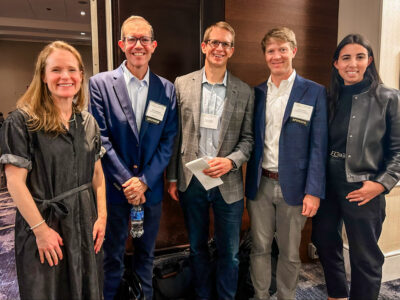“Help! I’ve fallen and I can’t get up!”
According to John Whitman, Wharton School adjunct and executive director of The TRECS Institute, medical alert systems like Life Alert (whose latest commercials play out like a scene from Saw) are one of the oldest and most reliable electronic tools in the health technology market.
[youtube https://www.youtube.com/watch?v=J4JzxG0cnpg]
For over 20 years, this technology has been a — well, life-saver — for seniors who choose to age at home.
Earlier this month, Whitman and the Philadelphia Health IT Circle (PHIT Circle) held a meeting at Ben Franklin Technology Partners’ Navy Yard offices to discuss improvements and innovations in home health IT.
“90 percent of seniors wish to age in place,” said Wharton’s Whitman. “With the aging bubble getting bigger, we have to come up with services that allow us to monitor people inexpensively.”
PHIT Circle, now counting over 600 members, hosted a panel of health professionals including Whitman, Dan Drake (President, St. Mary’s LIFE Program), Holly Lange (President & CEO, Philadelphia Corporation for Aging) and Steve Walsh (Director of Sales and Marketing, Friends Life Care). The panel discussed the current state of technology in home healthcare sector and what we have to look forward to in the not-so-distant future.
So, what kind of technology is available today for seniors who choose to continue aging in place instead of in a nursing home?
- Telikin. It’s a large, user-friendly touchscreen computer designed specifically for seniors. Grandpa can video chat, email and share photos with the whole family with relative ease. Simple, but it facilitates much-needed socialization and provides seniors with a nifty social support system.
- MedMinder. This is a digital pill dispenser. It beeps if grandma forgets to take her cholesterol meds. The MedMinder looks like a regular old seven-day pill box, except caregivers can log on to a website to program a schedule and monitor medicine intake. Medication adherence sounds simple, but it’s a major issue.
- Lively. A startup out of San Francisco offers a “Smart Home” product comprised of six wireless sensors that are placed around an elderly adult’s home. The sensors learn daily activity patterns and notify caregivers if something seems out of the ordinary. Smart Home operates on knowing that we’re creatures of habit.
- GrandCare Systems. A step or two above Telikin, this touchscreen computer tracks daily activity, has medical monitoring of glucose, oxygen, blood pressure and weight, and is capable of displaying anything from diets and exercises to pill schedules and hospital-discharge plans. Users can video chat, log onto Facebook, play games or read the news — and caregivers can log on to a website to monitor activity. Essentially, it’s a digital nurse. It may just be the closest thing we have to Jetsons technology in health right now.
“Where we’d use to have to put in a live-in home health aide,” said Walsh, of Friends Life Care, “we can put in a home monitoring system.”
Considering most of these technologies aren’t exactly affordable for most seniors, how do home caretakers decide between products?
“It always comes down to safety issues,” said Walsh. “It might be a great IT program, but will it be safe for our members at home?”
The Philadelphia Corporation for Aging’s Lange agreed with Walsh, but added three more important factors — ease of use, economic viability and mobility.
“If it includes any type of audio,” Drake joked, “make it loud.”
One thing is for sure. These technologies desperately need to be consolidated. “We can’t have 20 or 30 devices in a home,” said Whitman. “We need to look at a means of bringing it all together.”
What do you and I have to look forward to as seniors of the future?
MIT’s Department of Architecture has developed a “Home of the Future.” The technology will use a range of biometric sensors to track occupants’ daily habits in order to suggest preventative measures for diseases like congestive heart failure.
Would a “Home of the Future” be even remotely close to affordable for seniors? Probably not. Whitman concluded the recent PHIT Circle meeting by reiterating how cost-reduction should be a priority for developing new health IT, on par with innovation.
“Who’s going to pay for this technology?” he asked. That much remains to be seen.
Before you go...
Please consider supporting Technical.ly to keep our independent journalism strong. Unlike most business-focused media outlets, we don’t have a paywall. Instead, we count on your personal and organizational support.
3 ways to support our work:- Contribute to the Journalism Fund. Charitable giving ensures our information remains free and accessible for residents to discover workforce programs and entrepreneurship pathways. This includes philanthropic grants and individual tax-deductible donations from readers like you.
- Use our Preferred Partners. Our directory of vetted providers offers high-quality recommendations for services our readers need, and each referral supports our journalism.
- Use our services. If you need entrepreneurs and tech leaders to buy your services, are seeking technologists to hire or want more professionals to know about your ecosystem, Technical.ly has the biggest and most engaged audience in the mid-Atlantic. We help companies tell their stories and answer big questions to meet and serve our community.
Join our growing Slack community
Join 5,000 tech professionals and entrepreneurs in our community Slack today!

SEPTA riders complain of more bus cancellations. Here’s why that’s a good thing for Philly transit.

The metrics and mechanics that get startups funded, according to 5 active investors

A sneak peek inside Penn Engineering’s new $137.5M mass timber building

